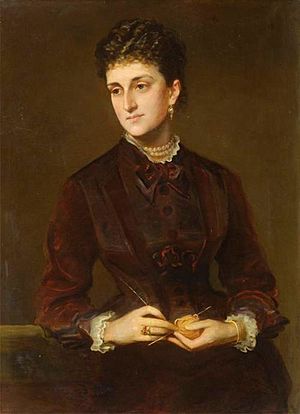Emily Gordon Cathcart facts for kids
Lady Emily Eliza Steele Gordon Cathcart (née Pringle) was born in 1845. Her father was John Robert Pringle. In 1865, she married Captain John Gordon. He was the son of Colonel John Gordon, who was known as "the richest commoner in the northern kingdom." Captain Gordon inherited a huge fortune from his father, valued at about £2-3 million in 1858, which would be worth much more today. This vast estate included Cluny Castle, North and South Uist, Benbecula, and Barra.
When Captain Gordon passed away in 1878 without children, Emily Gordon inherited all these lands. Later, in 1880, she married Sir Reginald Archibald Edward Cathcart. He became the sixth baronet of Cathcart in 1878. The Cathcart family's main home was Killochan Castle in Scotland. However, Lady Cathcart and Sir Reginald mostly lived in Titness Park, Sunninghill, Berkshire, England.
Contents
Lady Cathcart and the Highland Clearances
Lady Cathcart was known for her very strict views on land ownership. She played a big part in the Highland Clearances. This was a time when many people, called crofters, were moved off their homes and farms in the Scottish Highlands. Lady Cathcart continued these large-scale moves, which her first husband's father had started.
Many crofters living on her lands were moved to new homes far away. They were resettled in places like Regina and Wapella in Saskatchewan, Canada. This might have happened because Lady Cathcart owned shares in the Canadian Pacific Railway. This railway helped transport people across Canada.
Lady Cathcart did not live in the Highlands herself. It is believed she visited the area only once. In 1908, she had a disagreement with ten crofters from Vatersay. They did not want to leave their cottages. This led to a legal case.
The Askernish Golf Course
In 1891, Lady Cathcart asked a famous golf course designer, Old Tom Morris, to create a golf course. This course was built at Askernish on South Uist, part of her inherited lands.
She made sure to include a special rule in the agreements for her crofters. This rule allowed golf to be played on the land they rented. This meant that even though the crofters lived and worked on the land, golfers could use parts of it for their game.
Later Life and Legacy
Lady Cathcart passed away on August 8, 1932, in Margate, Kent. In her will, she wanted to set up a fund. This fund would help people move to Long Island, United States. However, this plan was never carried out. The people in charge of her will decided not to do it.
Images for kids



